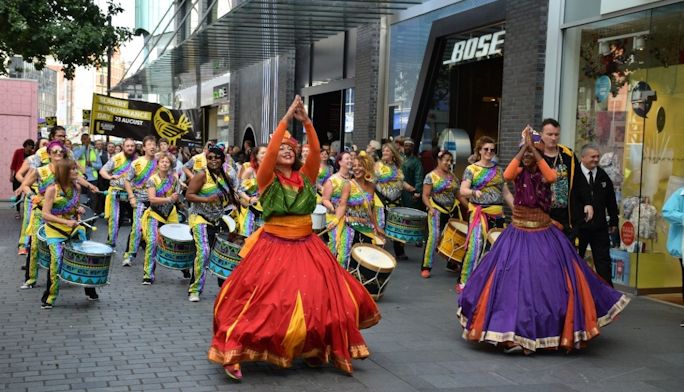Slavery in the Middle East and North Africa: An Untold Story?
by Yahya Almasri, Osaka University
The 2017 RENKEI PAX Workshop was a valuable academic opportunity to discuss collective memories and historical and contemporary forms of slavery around the world, mainly the infamous transatlantic one.
A number of slavery scholars, historians, curators and artists enriched the workshop with their diverse expertise. In addition, visits to slavery sites and tombs of the enslaved taught participants about the importance of remembering slavery.
The highlight of the workshop was the vibrant ’’Walk of Slavery’’ in Liverpool City. It took place on the Slavery Remembrance Day on 23 August 2017. 
Image: 'Walk of Slavery', Liverpool taken by the author
Many slavery scholars such as David Davis (slavery and Human Progress 1984), Ana Lucia Araujo (Shadows of the Slave Past 2014) and Jonathan Brown (Slavery and Islam 2017) agree that defining slavery is problematic. There seems to be no consensus among scholars whether coerced labor is sufficient to constitute slavery, or whether there must be an experience of physical torture, for example.
This is important because the study of slavery should be responsible and subjective without biased language or misleading euphemism. For instance, the victims of sex slavery are often referred to as “comfort women” in some East Asian countries. Actually this issue is one of those behind the current troubled political relations among China, Japan and the two Koreas.
Equally erroneous is the term “Islamic slavery”. This incorrectly connects a religion with a hideous practice of some of its followers. It suggests that Islam is a violent ideology or driving force behind slavery. On the contrary, freeing slaves was a common practice among early Muslims and one of factors behind the rapid spread of Islam. (Read both freeing Bilal Al-Habashi and Islam and Slavery) (1+2)
Transatlantic slavery was probably the darkest trade in history, but it probably the example that has been most researched. As our keynote speaker Professor Ana Lucia told us, there were an estimated 3-5 million Africans enslaved and brought to Brazil under inhumane conditions.
However, slavery in other parts of the word is understudied. For example, the history of slavery in the Middle East, mainly the Arabian Peninsula, is still untold. The majority of people in the Arab monarchies are unfamiliar with the history of slaves, whom descendants are now integrated citizens in their respective societies. From the second half of the 19th century until the Great Depression in the 1930s, approximately eight hundred thousand slaves were brought from East Africa to the Arabian Gulf (Matthew Hooper, 2015).
Moreover, slavery in this region has never ended. Contemporary forms of slavery are a global issue that must be addressed. According to one estimate, approximately 45.8 million people are in some forms of modern slavery across 167 countries (the Global Slavery Index, 2017)(3). In the Middle East and North Africa, the estimate is that around 2,936,800 people (6.4% of the total population of the region) live in modern slavery (Ibid).
Overall, the Arab governments do not appear serious in addressing slavery simply because they are engaged with the current geopolitical shifts in the aftermath of the so-call the “Arab Spring”. It is hard to estimate how many victims of slavery there are now in the war-torn countries in the region, but we need to think about the thousands of innocent people that are being enslaved or tortured by warring parties in Syria, Iraq, Yemen and Libya.
Although frowned upon for its exploitive working conditions, Qatar seems progressive in reconciling with its slavery past. In 2015, the Qatari government inaugurated the first slavery museum in the Middle East known as “The Bin Jelmood House”. (Reuters 2015)(4)
Slavery museums help shape collective memories and potentially mobilize the public in a certain direction. One of the arduous tasks of slavery scholars is to render the past usable, to learn from it instead of evoking hatred and hostility among multi-ethnic populations. I hope that one day the University of Liverpool’s Centre for the Study of International Slavery could initiate a fruitful academic cooperation with Qatari universities in the field of slavery studies.
References:
1- http://islam.wikia.com/wiki/Bilal_ibn_Rabah_al-Habashi
2- https://yaqeeninstitute.org/en/jonathan-brown/the-problem-of-slavery/
3- https://www.globalslaveryindex.org/findings/
4- http://www.reuters.com/article/us-qatar-slaverymuseum-doha/qatar-slavery-museum-aims-to-address-modern-exploitation-idUSKCN0T71XH20151118